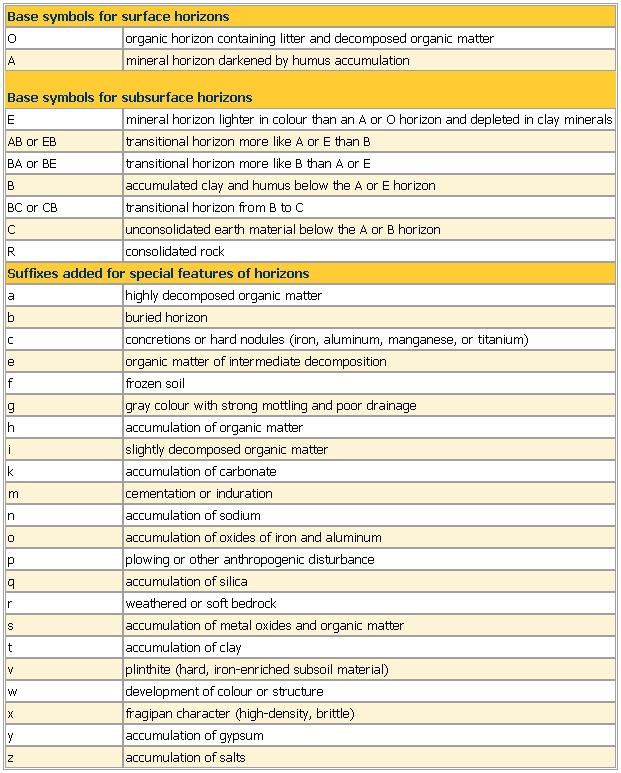- Soil Horizon letter designations
-
▪ TableSoil horizon letter designationsSee as table:
 Base symbols for surface horizonsO organic horizon containing litter and decomposed organic matterA mineral horizon darkened by humus accumulationBase symbols for subsurface horizonsE mineral horizon lighter in colour than an A or O horizon and depleted in clay mineralsAB or EB transitional horizon more like A or E than BBA or BE transitional horizon more like B than A or EB accumulated clay and humus below the A or E horizonBC or CB transitional horizon from B to CC unconsolidated earth material below the A or B horizonR consolidated rockSuffixes added for special features of horizonsa highly decomposed organic matterb buried horizone organic matter of intermediate decompositionf frozen soilg gray colour with strong mottling and poor drainageh accumulation of organic matteri slightly decomposed organic matterk accumulation of carbonatem cementation or indurationn accumulation of sodiumo accumulation of oxides of iron and aluminump plowing or other anthropogenic disturbanceq accumulation of silicar weathered or soft bedrocks accumulation of metal oxides and organic mattert accumulation of clayv plinthite (hard, iron-enriched subsoil material)w development of colour or structurex fragipan character (high-density, brittle)y accumulation of gypsumz accumulation of saltsSee as table:
Base symbols for surface horizonsO organic horizon containing litter and decomposed organic matterA mineral horizon darkened by humus accumulationBase symbols for subsurface horizonsE mineral horizon lighter in colour than an A or O horizon and depleted in clay mineralsAB or EB transitional horizon more like A or E than BBA or BE transitional horizon more like B than A or EB accumulated clay and humus below the A or E horizonBC or CB transitional horizon from B to CC unconsolidated earth material below the A or B horizonR consolidated rockSuffixes added for special features of horizonsa highly decomposed organic matterb buried horizone organic matter of intermediate decompositionf frozen soilg gray colour with strong mottling and poor drainageh accumulation of organic matteri slightly decomposed organic matterk accumulation of carbonatem cementation or indurationn accumulation of sodiumo accumulation of oxides of iron and aluminump plowing or other anthropogenic disturbanceq accumulation of silicar weathered or soft bedrocks accumulation of metal oxides and organic mattert accumulation of clayv plinthite (hard, iron-enriched subsoil material)w development of colour or structurex fragipan character (high-density, brittle)y accumulation of gypsumz accumulation of saltsSee as table:
* * *
Universalium. 2010.
